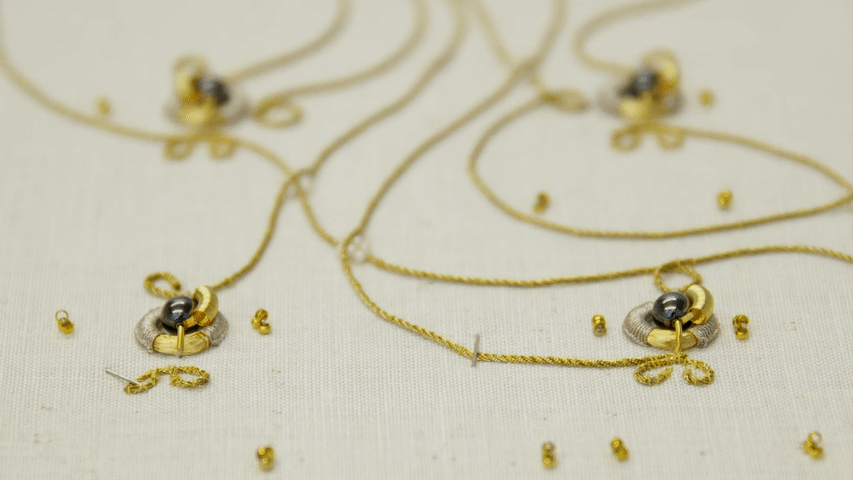Spend enough time reading about emerging technologies and, at some point, you will find yourself questioning some of your dearly held beliefs. It gives a whole new meaning to term, mind altering (also, mind blowing or mind expanding), which in the 1960s was used to refer to the effects of LSD and other hallucinogens. Today <September 1, 2019 (Labour Day in Canada and elsewhere), I have two news bits that could be considered mind expanding, sans hallucinogens.
Gold-embroidered computers

If you look closely, you’ll see the beads shift position and that’s how the ones and zeroes make themselves known on this embroidered computer. An August 23, 2019 article (updated from a March 8, 2019 article) on the CBC’s (Canadian Broadcasting Corporation) Radio, Spark programme web space, provides insight into the work,
A beautiful ’embroidered computer’ may explode our categories of what computers are supposed to look like.
After all, we may think the design of a computer is permanent, but what a computer ‘looks like’ depends a lot on what era it’s from.…
“We use gold-coloured copper wire to form a coil, in a donut shape” Posch told Spark host Nora Young. “Then we have a magnetic bead that sits in the middle of this coil, and when this coil is [connected to] power, the magnetic bead is either attracted or pushed away….
Depending on how we power… the embroidered coil, we can direct the magnetic bead in different positions.”
More gold embroidery on top of the bead will flip one way or another, based on the bead [above].
The process is analogous to the zeros and ones of computation.
As well as being an artist, Posch is a professor at the University for Art and Industrial Design in Linz, Austria. Much of her work and research uses textile art to explore digital technology.
In this case, it’s not like Irene expects people to start doing today’s heavy-duty computing on a two-metre-long, eight-bit golden embroidered fabric computer. But The Embroidered Computer project opens up space to question the design of computers in particular, but also our technologies in general
“I understand The Embroidered Computer as an alternative, as an example, but also a critique of what we assume a computer to be today, and how it technically could be different,” Posch said. “If this is actually what we want is a whole different question, but I think it’s interesting to propose an alternative.”
…
Bringing together textiles and electronics, which are normally seen as worlds apart, can bring new insights. “Going into the history of computing we very soon become aware that they’re not that apart as we sometimes think they are, if you think of the Jacquard weaving loom as one of the predecessors of computing today.”
You can find our more about the artists (Ebru Kurkak here) and (Irene Posch here). Finally, you can hear the Spark radio interview with Irene Posch here.
ORBITALY 2019
I don’t have a lot of information about this event but what I do have looks intriguing. From the ORBITALY 2019 conference home page,
OrBItaly (Organic BIoelectronics Italy) is an international conference, organized by the Italian Scientific Community and attended by scientists of the highest reputation, dedicated to the most recent results in the field of bioelectronics, with a particular focus on the employment of organic materials.
OrBItaly has attracted in the years a growing interest by scientists coming from all over the world. The 2019 edition is the fifth one of this cross-disciplinary conference, and will be held in Naples, on October 21st-23rd, 2019, at the Congress Center of the University Federico IIThis year the conference will be preceded by the first edition of the Graduate School in Organic Bioelectronics, that will be held at the Congress Center of the University of Naples Federico II in Naples (Italy), on October 20th, 2019. The school is mainly targeted to PhD students, post-docs and young researchers as well as to senior scientists and industry-oriented researchers, giving them the opportunity to attend an overview of the latest advances in the fields of organic bioelectronics presented by leading scientists of the highest international repute. Invited lecturers will provide highly stimulating lessons at advanced levels in their own field of research, and closely interact with the attendees during platform discussions, outreach events and informal meetings.
Organizing CommitteeMario Barra, CNR – SPIN, mario.barra@spin.cnr.it
Irene Bonadies, CNR – IPCB, irene.bonadies@ipcb.cnr.it
Antonio Cassinese, Univ. Napoli Federico II, cassinese@na.infn.it
Valeria Criscuolo, IIT, valeria.criscuolo@iit.it
Claudia Lubrano, IIT, claudia.lubrano@iit.it
Maria Grazia Maglione, ENEA, mariagrazia.maglione@enea.it
Paola Manini, Univ. Napoli Federico II, paola.manini@unina.it
Alessandro Pezzella, Univ. Napoli Federico II, alessandro.pezzella@unina.it
Maria Grazia Raucci, CNR – IPCB, mariagrazia.raucci@cnr.it
Francesca Santoro, IIT, francesca.santoro@iit.it
Paolo Tassini, ENEA, paolo.tassini@enea.it
So, the conference runs from the 21st to the 23rd of October 2019 and there’s a one-day graduate school programme being held one day prior to the conference on the 20th of October 2019.
Regular readers may notice that some of the ORBITALY 2019 organizers have recently been mentioned here in an August 25, 2019 posting titled, Cyborgs based on melanin circuits.